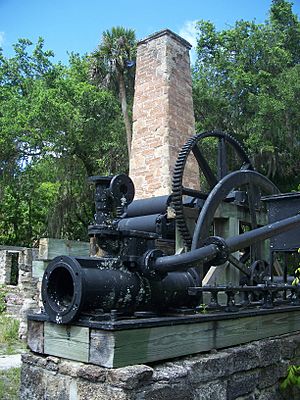Dunlawton Plantation and Sugar Mill facts for kids
Quick facts for kids |
|
|
Dunlawton Plantation-Sugar Mill Ruins
|
|
 |
|
| Location | Port Orange, Florida |
|---|---|
| NRHP reference No. | 73000606 |
| Added to NRHP | August 28, 1973 |
The Dunlawton Plantation and Sugar Mill is a cool historical spot in Port Orange, Florida. It used to be a big farm that grew sugar cane way back in the 1800s. Today, you can visit the ruins of the old sugar mill, which are part of the Dunlawton Sugar Mill Gardens.
This special place is more than just old ruins. It's a botanical garden with lots of plants, a gazebo, and even huge concrete statues of dinosaurs and a giant ground sloth! On August 28, 1973, the site was added to the United States National Register of Historic Places.
Contents
History of Dunlawton Plantation
Early Days of the Plantation
The Dunlawton Plantation and its sugar mill started a long time ago, when Florida was still under Spanish rule. In 1804, a man named Patrick Dean began a large farm here. He grew indigo and sugar cane. Enslaved people were forced to do the hard work of planting and processing the crops.
After Patrick Dean passed away, the plantation went through a few owners. Eventually, in 1832, Sarah Anderson and her two sons, George and James, bought the land. They combined Sarah's maiden name, Dunn, with the name of the land dealers, Lawton, to create "Dunlawton." The Anderson brothers continued to run the sugar mill using the labor of enslaved people. They made sugar, molasses, and rum.
The Second Seminole War
Life at the plantation changed when the Second Seminole War began in December 1835. White settlers in Florida were worried about conflicts with the Seminole people. Some Seminole leaders, like Osceola, were against the United States government's plan to move Native Americans from their lands.
On December 24, 1835, Seminole groups began attacking plantations south of St. Augustine. Over the next few weeks, many plantations, including Dunlawton, were burned or damaged. Soldiers tried to protect the area. On January 17, 1836, a group of soldiers found Seminoles still at Dunlawton. There was a fight, and some buildings at the plantation were burning. The Seminoles managed to force many white settlers to leave the area south of St. Augustine.
Rebuilding the Sugar Mill
After the war, in 1846, Sarah Anderson sold Dunlawton to John J. Marshall. He was a master builder who wanted to make the sugar plantation successful again. He rebuilt the mill and added new machinery. In 1851, he produced almost 200 tons of sugar!
However, the sugar market eventually became difficult, and Marshall had to sell the property. This marked the end of Dunlawton Plantation as a major sugar producer. The land was then used for different purposes over the years.
Civil War and Later Years
During the American Civil War, the large kettles used for boiling sugar cane juice at Dunlawton were repurposed. They were used by Confederate soldiers to make salt. A group of Confederate scouts even used the millhouse as their headquarters.
Years later, in 1906, something unusual happened. Two whales washed ashore near the Port Orange bridge. Their bodies were brought to Dunlawton plantation. The old furnaces were fired up, and the oil from the whales' blubber was extracted in the very same kettles that once boiled sugar cane juice!
Today, you can still see the remains of the sugar mill. These include stone and brick structures, along with parts of the old sugar processing equipment. You can see the gears of the cane press, the iron boiling kettles, and parts of the steam engine. These ruins show us how sugar was made long ago.
Bongoland: The Dinosaur Park
In 1948, a doctor named Perry Sperber leased the Dunlawton property. He opened one of Florida's first theme parks called Bongoland! It was named after Bongo, a trained baboon who lived there. The park was open from 1948 to 1952.
Visitors could ride a miniature train past huge statues of "prehistoric monsters." These were dinosaurs made from chicken wire and concrete by an artist named M.D. "Manny" Lawrence. Five of these statues are still there today! You can see a triceratops, a stegosaurus, a tyrannosaurus rex, a dimetrodon, and a giant ground sloth.
In 1963, the land was given to the county, and the dinosaur statues were kept. Today, these cool dinosaur sculptures are a fun part of the Dunlawton Sugar Mill Gardens.




